I'm undertaking a project to visit all 598 Underground, Overground, National Rail, DLR, Tram and Cable Car stations in Greater London in alphabetical order. Here's Day 2.
It's a chilly start on the 24th November as I head out to my first destination of today's trip, via Waterloo and Waterloo East. Breakfast taken on a near-empty Southeastern class 376, I change at Hither Green for a train to...
Albany Park (AYP)
Station opened: 7th March 1935
Railway opened: 1st September 1866 (by the South Eastern Railway)
Served by: Southeastern
Zone: 5
Passenger entries/exits (2016/17): 0.967 million
Stations served:
- Cannon Street (4tph, 2 via Woolwich Arsenal)
- Charing Cross (2tph)
- Gravesend (2tph)
Albany Park lies on the Dartford Loop Line, which runs from Dartford to Hither Green. It was the last station opened on the line, built at the behest of the housing development company who were constructing large estates in the then farmland for inner London families to move out to. The two platforms lie in a cutting which, with the help of the copious tree cover, helps to give the station an almost countryside feel, particularly as I have the station to myself at this moment. Albany Park is the least used of the 8 stations on the line, the only one indeed to see less than 1 million passengers pass through in 2016/17. Exiting the station
brings me out at the end of a cul-de-sac, lined on either side with various retails outlets including Smarty Pants Dry Cleaners, 3 hairdressers and a carpet shop. Straight ahead is
The Albany pub, which, according to their website, hosts weekly meetings of the Bexley Ukelele Club. The
station building is a squat brick structure, with a low ceilinged ticket office; it almost feels like it's trying to be unobtrusive, not getting in the way. I pass back through the ticket office, and await the next London-bound service; the few minutes give me time to admire the
artwork on both platforms, produced by students of Bexleyheath Academy in partnership with Southeastern.
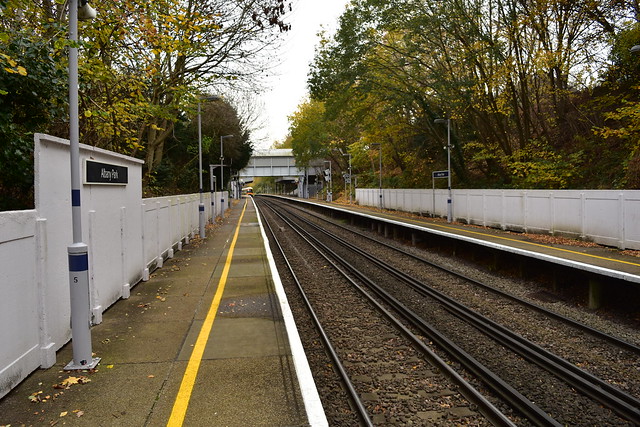
Eventually the train to Cannon Street rolls in; I jump aboard and ride it all the way to the end, where I change for a Circle line train to...
Aldgate (ALD)
Station opened: 18th November 1876
Railway opened: 18th November 1876 (by the Metropolitan Railway)
Served by: London Underground Circle and Metropolitan lines
Zone: 1
Passenger entries/exits (2017): 8.85 million
Stations served:
- Amersham (2tph)
- Chesham (2tph)
- Uxbridge (8tph)
- 6tph in each direction on the Circle Line
Aldgate is served by the Circle and Metropolitan Underground lines, and is the terminus of the latter. The station was one of the last to be opened on what we now know as the Circle, being a terminus at the end of an extension from Liverpool Street for 6 years before the railway was extended through to (what is now) Tower Hill in 1882. The station's 4 platforms lie under a low brick ceiling, criss-crossed by riveted metal bars and lit by jarringly modern fluorescent strips. The effect is rather claustrophobic, particularly when combined with the narrow platform width, and it's somewhat of a relief to ascend the stairs into the airier mezzanine level.
Here you'll find a destination board with each platform's next train listed, and a small horticultural display underneath (which, alas, was not looking its best in late November). It's also much easier to appreciate the original train shed from this vantage point, and to look across to St Botolph Street which runs along the back of the shed. Stepping through the ticket hall,
I emerge on Aldgate High Street, the lesser known prequel to the A11. Traffic, both vehicular and pedestrian, rushes past Peter's Cafe and Aldgate Travel Goods (Stock Clearance ongoing), while to the west, the bulbous figure of 20 Fenchurch Street rises above the surrounding buildings. The
station frontage is clad in (well, what once was) white marble faience, with lettering across the top proclaiming the station name, as well as name-checking the Metropolitan Railway in initialled form. Black Sheep Coffee occupy one of the retail units; the other lies empty behind opaque windows. Sandwiched as it is between two bland office blocks, the station feels low and cramped even on the outside, matching the platforms.
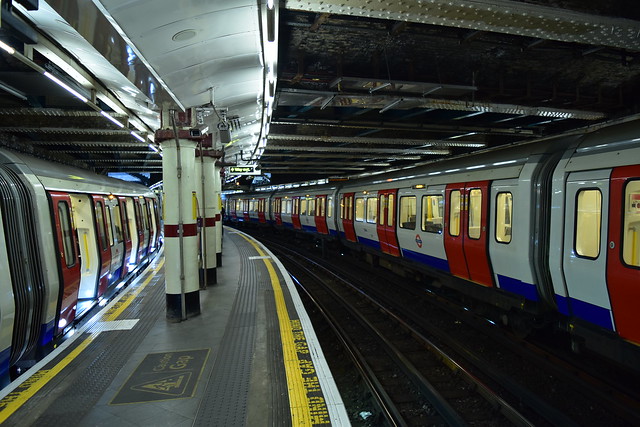
I leave Aldgate behind, and take a short walk up the road, to...
Aldgate East (ALE)
Station opened: 6th October 1884 (resited 31st October 1938)
Railway opened: 1st October 1884 (by the District Railway)
Served by: London Underground District and Hammersmith & City lines
Zone: 1
Passenger entries/exits (2017): 14.00 million
Stations served:
- Barking (9tph)
- Ealing Broadway (6tph)
- Hammersmith (6tph)
- Richmond (6tph)
- Upminster (12tph)
- Wimbledon (3tph)
Aldgate East lies on the District and Hammersmith & City lines, the first station (or last, depending on your perspective) to be served by both. Opened in 1884, it was resited in 1938 to allow for the expansion of the triangular junction to the east. The station has a rather underwhelming street presence, having no significant surface buildings; only 4 entrances, two at the western end of the station and two at the eastern end (one on each side of Whitechapel Road, under which the platforms lie). I arrive at the northwestern (so as to speak)
entrance, which is built into another office block and clad in some sort of faux brownish marble.
Across the road lies the other western entrance, a standalone structure in the shadow of Aldgate Tower; architecturally it is, quite frankly, unremarkable. I head through the ticket hall and down to platform level, where I find a much brighter, airier space than at Aldgate. This is mostly due to the resiting; in order to make the new station completely subsurface, the track was lowered by around 7 feet. The platforms are tiled in light cream with blue borders at regular intervals, which helps with the light, welcoming feel of the station. Above, more riveted metalwork criss-crosses the roof above the tracks; dotted here and there are hooks, from which chains suspended the track during the aforementioned lowering (the trackbed was dug out from underneath the track, which was supported on wooden trestles until excavation was complete; the track was then lowered into place over the course of a single night).
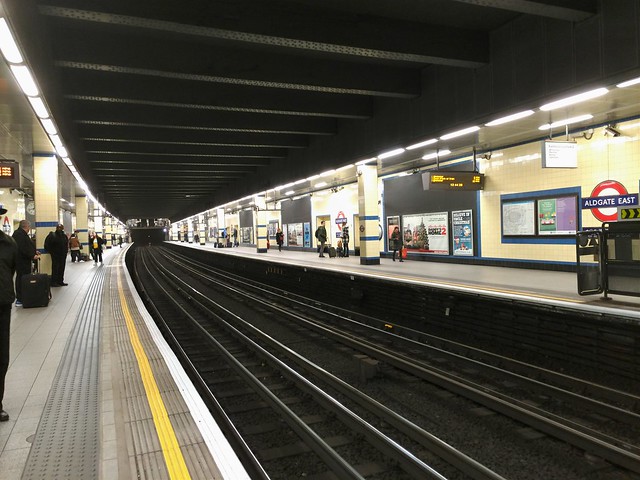
A Hammersmith & City line train rolls in, and I board for a short hop to Moorgate, where I change to take one of my favourite train services in London; the Northern City Line. Formerly a London Underground line, ownership was transferred to British Rail in 1976, and the subterranean stations, from Moorgate to Drayton Park, all retain Network Southeast branding. Quite marvellous. From Moorgate I take a Great Northern train, alighting at...
Alexandra Palace (AAP)
Station opened: 1st May 1859 (as Wood Green)
Railway opened: 7th August 1850 (by the Great Northern Railway)
Served by: Great Northern
Zone: 3
Passenger entries/exits (2016/17): 1.622 million
Stations served:
- Hertford North (1tph)
- Moorgate (6tph)
- Stevenage (1tph)
- Watton-at-Stone (1tph)
- Welwyn Garden City (3tph)
Alexandra Palace is situated on the Great Northern Route, the southern part of the East Coast Main Line. Opened several years after the railway, the station is a junction station, with the Hertford Loop diverging from the mainline just to the north. The station has 4 platforms straddling 6 lines, 2 of which are fast lines. The platforms are surfaced with a rather nice pinkish brick, which is a stark contrast to the
ugly footbridge that links all the platforms with the ticket office, and provides pedestrian access from one side of the railway to the other. I take the footbridge to said ticket office, and
emerge out onto the imaginatively named Station Road. A steady stream of traffic flows past The Starting Gate pub (located at the original start point of the Alexandra Palace Racecourse, hence the name). Coming back from a newsagents on St Michael's Terrace gives me the opportunity to get a good look at the
station building. Constructed out of light brick, the windows and doors are surmounted by terracotta arches, and the building is topped off with a dark slate roof. There used to be station buildings on the western side of the railway as well, but these are no longer in use.
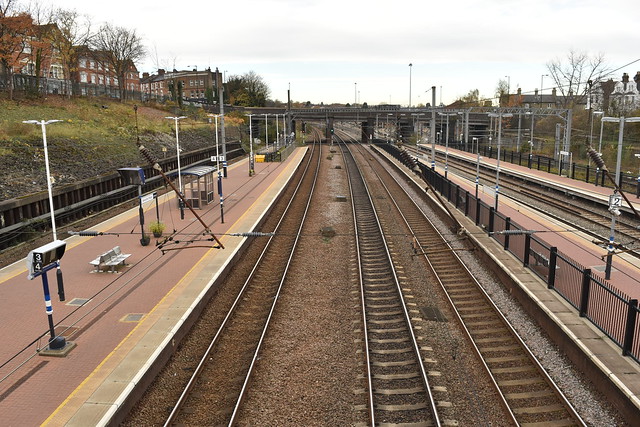
I decide I can't really visit the station without also visiting its namesake, so I cross the footbridge and slog up the hill towards that
famous broadcasting tower. I recall from a previous visit there is a cafe by the boating lake, and I have a lovely spot of lunch watching the ducks and a couple of hardy joggers. Refuelled, I climb up to the palace itself; last time I was here it was very foggy and the excellent view was rather obscured, but today the panorama southwards is crystal clear. I spend a few minutes admiring the
vista, then head back down the hill. Onto a Great Northern service, changing at Highbury & Islington for an Overground service to Stratford, then a DLR down to...
All Saints (ALS)
Station opened: 31st August 1987
Railway opened: 31st August 1987 (by the Docklands Light Railway, on the trackbed of the former North London Railway)
Served by: Docklands Light Railway
Zone: 2
Passenger entries/exits (2016): 2.160 million
Stations served:
- Canary Wharf (6tph)
- Stratford (6tph)
All Saints is located on the DLR branch between Poplar and Stratford. It was built on the site of the former North London Railway's Poplar station (not to be confused with the former London & Blackwall Railway's Poplar station; neither are to be confused with the current DLR station!). As one of the original stations on the DLR network, All Saints retains much of its 1987 character, such as the classic blue-ribbed canopies and bright red handrails. I take the stairs up to the entrance to the station; here you'll find a couple of ticket machines, and some Oyster readers, underneath a
rather ugly canopy.
Outside the station runs the busy A13, otherwise known as East India Dock Road. Immediately my eye is drawn to a large mural daubed on the side of a block of flats across the road, depicting a derpy yet starry-eyed
chihuahua. Not quite to my taste, but impressive nonetheless. Having crossed the road to get a better look at the front of the station, I return to the southbound platform; looking up my next destination, I deem it too far to get to before darkness falls, and so end my day at All Saints.
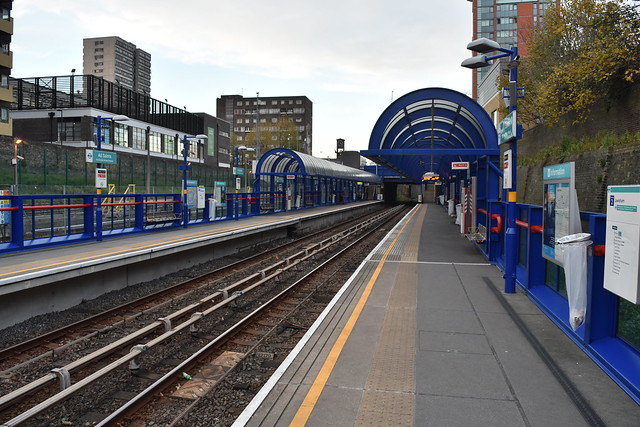
I may not have visted very many stations today, but to be honest, this project isn't about rushing around everywhere in the shortest time possible; it's about enjoying the travel, and the exploration of nearly every corner of London. In that respect, I'm doing well so far. Until next time...





No comments:
Post a Comment